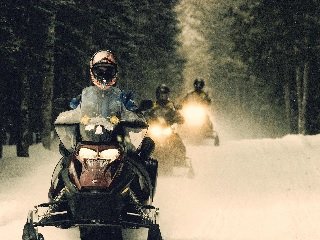 Winter is just around the corner, much to the delight of snowmobiling enthusiasts. For those new to the sport, read on to learn how to get started, with answers to the most frequently asked questions.
Winter is just around the corner, much to the delight of snowmobiling enthusiasts. For those new to the sport, read on to learn how to get started, with answers to the most frequently asked questions.
Where can I go snowmobiling?
There are riding areas throughout the Snowbelt regions of the United States and Canada. Your state and provincial snowmobile associations have detailed information, and can also put you in touch with local clubs who are familiar with the trail systems in your area. These clubs maintain the trails, and are able to give expert advice on areas that are appropriate for your skill level.
There are over 3000 snowmobile clubs in North America, and all of them welcome new members. These clubs encourage people to ride together, and they also hold functions throughout the year so you can meet and make new friends at any time.
Do I need a license or permit to ride?
Every state and province requires that your snowmobile is properly licensed or registered. Licensing information pertaining to your state is available from a local snowmobile club, the state natural resources office, or the highway department. Licensing requirements vary from state-to-state.
Some areas require a safety class. Check locally with your state or provincial snowmobile association. It’s always recommended that new riders take a safety class and often local snowmobile clubs hold training sessions you can attend at no charge or for a minimal fee.
What type of snowmobile should I buy?
There are four major snowmobile manufacturers: Arctic Cat, Ski-Doo, Polaris, and Yamaha, and a variety of snowmobiles to choose from.
Entry-level snowmobiles are frequently referred to as trail models. Engines range from 60-70 horsepower. These sleds are light and easy to handle, and can be equipped with electric start. They are relatively inexpensive and a good choice for beginners to the sport.
Performance snowmobiles have higher horsepower, from 85 and up. They are heavier than the entry-level models due to the engine size and the weight related to the suspension systems and shock absorbers. These sleds often have reverse gear and electronic start.
Touring snowmobiles have a seat configuration designed for up to two people, and a comfortable backrest. They also normally include side-mounted mirrors, larger windshields, reverse gear, and electronic start. Because they are designed for riding long distances in comfort, touring sleds are heavier than entry level and performance models. They have a greater track length to cushion the ride and add more stability while accommodating two riders.
Mountain snowmobiles are long and narrower, configured to allow for riding mountainous terrain and plowing through heavy snow. These sleds also have long lug tracks, designed for easy maneuvers in deep powder. They generally have high power engines to compensate for the loss of horsepower that occurs at higher elevations.
Utility snowmobiles are used to tow work sleds and toboggans. They’re longer, slightly wider, and heavier than other models, and come equipped with reverse and electric starts.
Crossover snowmobiles go from trail to powder with ease. They have longer tracks for deep powder and they can move off-trail with suspension enhancements for better handling. Crossover sleds are a great choice for trail riders who want the option to explore into the woods.








